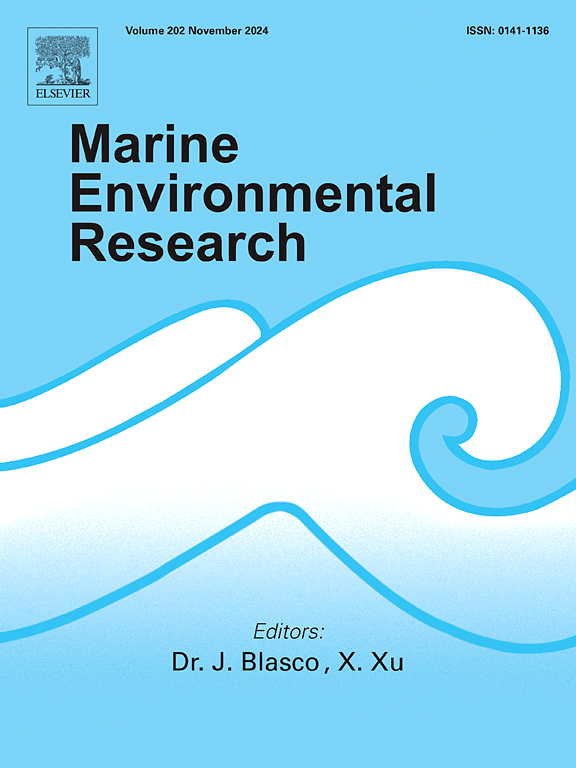河流流入和海水入侵形成了黄海静海湾独特的浮游植物群落
IF 3.2
3区 环境科学与生态学
Q2 ENVIRONMENTAL SCIENCES
引用次数: 0
摘要
浮游植物是塑造河口生态系统结构和功能的关键初级生产者。然而,河流输入和海水入侵对浮游植物群落的明显影响尚不清楚。研究了2023年春夏季静海湾浮游植物的季节动态,重点研究了河流流入和海水入侵的对比影响。我们的数据显示了两个不同的区域:低盐度和高营养物的河流影响区(RIZ)和高盐度和低营养物的海水入侵区(SIZ)。春季,试验区浮游植物丰度和均匀度较高,试验区浮游植物丰富度较高。夏季,RIZ优势物种丰富度较高,优势物种简化,而SIZ则保持较高的多样性和均匀性。环境驱动因素也存在差异:RIZ浮游植物动态主要受DIN、DIP和温度的影响,而SIZ浮游植物动态受盐度梯度的影响。冗余分析进一步表明,盐度与滨海区浮游植物多样性呈正相关,与滨海区优势种呈负相关。这些发现表明,河流流入通过改变群落组成来促进浮游植物的生长,而海水入侵则施加盐度驱动的选择。总的来说,我们的研究结果突出了河流流入和海水入侵调节河口生态系统浮游植物特性的不同机制。本文章由计算机程序翻译,如有差异,请以英文原文为准。
River inflow and seawater intrusion shape distinct phytoplankton communities in jinghai bay, a coastal bay of the Yellow Sea
Phytoplankton are key primary producers that shape the structure and function of estuarine ecosystems. However, the distinct effects of riverine inputs and seawater intrusion on phytoplankton communities remain unclear. This study investigated the seasonal dynamics of phytoplankton in Jinghai Bay during spring and summer 2023, focusing on the contrasting influences of river inflow and seawater intrusion. Our data revealed two distinct zones: a river-influenced zone (RIZ) with low salinity and high nutrients, and a seawater-intrusion zone (SIZ) with high salinity and low nutrients. In spring, the SIZ exhibited higher phytoplankton abundance and evenness, while the RIZ showed greater species richness. During summer, the RIZ had higher abundance and simplified dominant species, whereas the SIZ maintained higher diversity and evenness. Environmental drivers also differed between the two zones: phytoplankton dynamics in the RIZ were mainly shaped by DIN, DIP, and temperature, while those in the SIZ were governed by salinity gradients. Redundancy analysis further revealed that salinity positively correlated with phytoplankton diversity in the SIZ but negatively with dominant species in the RIZ. These findings suggest that river inflow promotes phytoplankton growth by altering community composition, while seawater intrusion imposes salinity-driven selection. Overall, our results highlight the contrasting mechanisms through which river inflow and seawater intrusion regulate phytoplankton traits in estuarine ecosystems.
求助全文
通过发布文献求助,成功后即可免费获取论文全文。
去求助
来源期刊

Marine environmental research
环境科学-毒理学
CiteScore
5.90
自引率
3.00%
发文量
217
审稿时长
46 days
期刊介绍:
Marine Environmental Research publishes original research papers on chemical, physical, and biological interactions in the oceans and coastal waters. The journal serves as a forum for new information on biology, chemistry, and toxicology and syntheses that advance understanding of marine environmental processes.
Submission of multidisciplinary studies is encouraged. Studies that utilize experimental approaches to clarify the roles of anthropogenic and natural causes of changes in marine ecosystems are especially welcome, as are those studies that represent new developments of a theoretical or conceptual aspect of marine science. All papers published in this journal are reviewed by qualified peers prior to acceptance and publication. Examples of topics considered to be appropriate for the journal include, but are not limited to, the following:
– The extent, persistence, and consequences of change and the recovery from such change in natural marine systems
– The biochemical, physiological, and ecological consequences of contaminants to marine organisms and ecosystems
– The biogeochemistry of naturally occurring and anthropogenic substances
– Models that describe and predict the above processes
– Monitoring studies, to the extent that their results provide new information on functional processes
– Methodological papers describing improved quantitative techniques for the marine sciences.
 求助内容:
求助内容: 应助结果提醒方式:
应助结果提醒方式:


